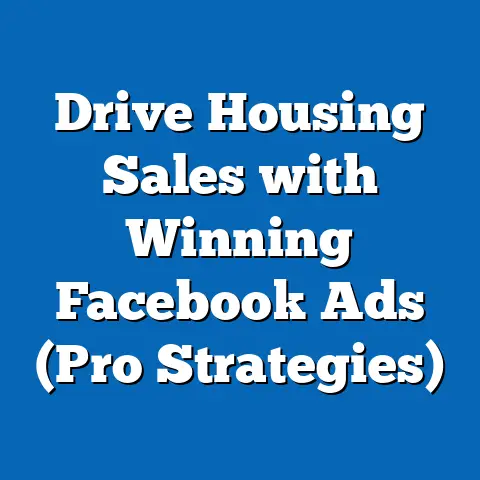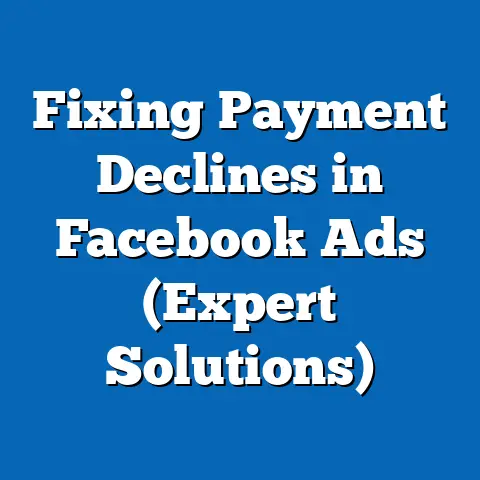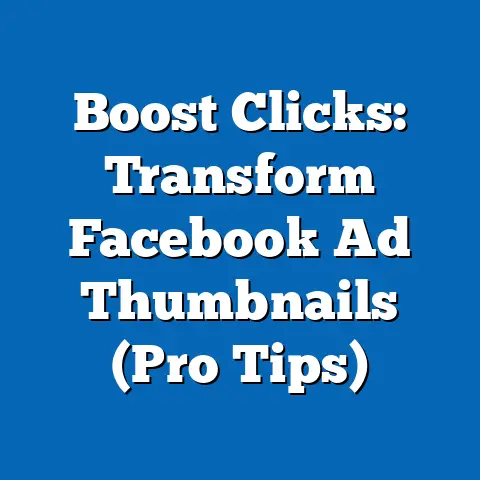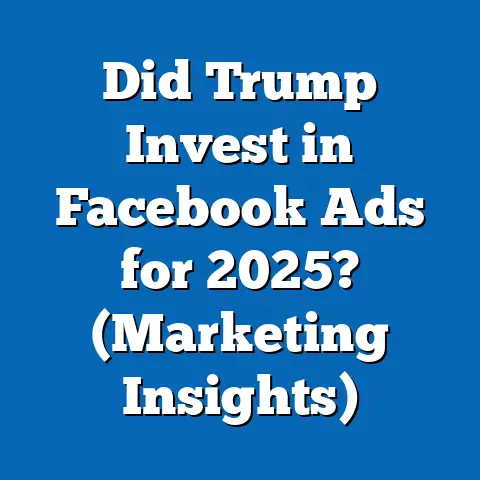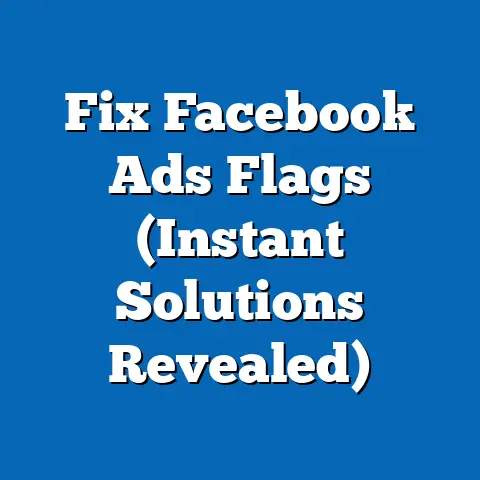Stop Wasting fb ad Spend (Essential Tactics for Success)
In the digital marketing landscape, Facebook (now part of Meta) remains a dominant platform for businesses aiming to reach vast audiences. With over 2.9 billion monthly active users as of 2023, according to Statista, it offers unparalleled opportunities for targeted advertising. However, a common problem persists: businesses are wasting significant portions of their ad budgets due to poorly optimized campaigns, irrelevant targeting, and lack of strategic planning.
A 2022 report by Hootsuite revealed that the average cost-per-click (CPC) for Facebook ads across industries is $1.72, with some sectors like finance and insurance reaching up to $3.77 per click. Despite these costs, a study by WordStream found that nearly 62% of small businesses report that their Facebook ads fail to reach their intended audience or generate meaningful returns. This inefficiency translates to billions of dollars lost annually, with small and medium-sized businesses (SMBs)—a demographic that makes up 90% of advertisers on the platform, per Meta’s 2022 data—bearing the brunt of the waste.
Demographically, younger businesses (those under five years old) and industries like e-commerce and retail are most prone to overspending without results, often due to a lack of expertise in ad optimization. This article delves into the root causes of wasted Facebook ad spend, historical trends in ad performance, and essential tactics for success. By leveraging data-driven strategies, businesses can transform their ad spend into measurable returns.
The Scale of Wasted Ad Spend: A Closer Look at the Numbers
Wasted ad spend on Facebook is not a niche issue; it’s a pervasive problem affecting businesses of all sizes. According to a 2021 analysis by Forrester, companies globally squander approximately 30% of their digital advertising budgets due to poor targeting, irrelevant creative content, and lack of performance tracking. For Facebook specifically, this translates to an estimated $12 billion in wasted spend annually, given that global ad revenue for the platform reached $40.5 billion in 2022, as reported by eMarketer.
Historically, the issue of wasted spend has grown alongside the platform’s expansion. In 2015, when Facebook ad revenue was $17 billion, a Nielsen study estimated that only 20% of ad budgets were misallocated. By 2023, with ad revenue more than doubling, the proportion of wasted spend has risen due to increased competition and higher CPCs. This trend underscores the urgency for businesses to adopt smarter strategies.
Demographic patterns reveal disparities in ad performance. SMBs, particularly those with annual revenues under $1 million, report lower return on ad spend (ROAS) compared to larger enterprises. A 2022 survey by Databox found that SMBs achieve an average ROAS of 3:1 on Facebook ads, while larger companies with dedicated marketing teams often see returns of 5:1 or higher. This gap highlights the need for accessible, actionable tactics tailored to resource-constrained advertisers.
Why Facebook Ad Spend Goes to Waste: Root Causes
Understanding why ad spend is wasted is the first step toward optimization. Several key factors contribute to this issue, each backed by data and industry insights.
1. Poor Audience Targeting
One of the most significant causes of wasted spend is improper audience targeting. A 2023 report by Social Media Today found that 45% of businesses fail to use Facebook’s detailed targeting options effectively, resulting in ads being shown to irrelevant users. For instance, e-commerce brands often target overly broad audiences, leading to low click-through rates (CTRs) averaging just 0.9%, compared to the industry benchmark of 1.5%, per WordStream data.
2. Lack of Creative Testing
Creative elements like images, videos, and ad copy play a critical role in engagement. However, a 2022 study by AdEspresso revealed that 58% of advertisers do not test multiple ad variations, missing opportunities to identify high-performing content. Without A/B testing, businesses risk spending on underperforming creatives, driving up costs without improving results.
3. Ignoring Performance Metrics
Many advertisers fail to monitor key performance indicators (KPIs) such as CTR, conversion rate, and cost-per-acquisition (CPA). According to a 2021 survey by HubSpot, 37% of small business owners admit to rarely analyzing their ad performance data. This oversight prevents them from identifying and pausing underperforming campaigns, leading to continuous budget drain.
4. Over-Reliance on Automated Tools
While Facebook’s automated ad tools, like Advantage+ Placements, can streamline processes, over-reliance often results in suboptimal outcomes. A 2023 analysis by Marketing Land found that manually optimized campaigns outperformed automated ones by 22% in terms of ROAS for experienced advertisers. Automation can be a starting point, but human oversight is essential for fine-tuning.
Historical Trends in Facebook Ad Performance
To contextualize the current state of Facebook advertising, it’s helpful to examine historical trends. In 2012, when Facebook first rolled out its modern ad platform, the average CPC was just $0.58, according to a report by Salesforce. Engagement rates were also higher, with CTRs averaging 2.5% due to less ad saturation and novelty among users.
By 2018, as ad inventory grew and competition intensified, CPCs rose to $1.29, and CTRs dropped to 1.2%, per WordStream’s historical data. This period also saw the introduction of stricter privacy policies, like the General Data Protection Regulation (GDPR) in Europe, which limited targeting capabilities and increased costs for advertisers. Fast forward to 2023, and the landscape is even more challenging, with CPCs at $1.72 and CTRs hovering around 0.9-1.5% depending on the industry.
Demographic engagement has also shifted over time. In 2015, younger users (18-24) were the most engaged demographic, clicking on ads at rates 30% higher than older cohorts, per Pew Research. By 2023, however, engagement has balanced out, with 25-34-year-olds showing the highest CTRs due to their purchasing power and platform usage patterns, according to Meta’s internal data.
These trends highlight a clear pattern: as the platform matures, advertisers must work harder and smarter to achieve results. The days of cheap clicks and easy engagement are over, necessitating a focus on precision and strategy.
Demographic Differences in Ad Performance
Not all advertisers face the same challenges on Facebook. Demographic differences among businesses and their target audiences significantly impact ad performance.
Business Size and Resources
As mentioned earlier, SMBs struggle more than large enterprises. A 2022 report by eMarketer found that businesses with ad budgets under $5,000 per month achieve an average ROAS of 2.8:1, compared to 4.5:1 for those spending over $50,000. Larger budgets allow for more testing and broader reach, while smaller advertisers often lack the resources for experimentation.
Industry Variations
Industry type also plays a role. According to WordStream’s 2023 data, the legal industry sees the highest CPCs at $2.93, driven by high competition and valuable leads. In contrast, apparel and retail average $0.45 per click but struggle with low conversion rates due to impulse-driven purchases. Understanding industry benchmarks is crucial for setting realistic expectations and budgets.
Target Audience Age and Location
Audience demographics further influence outcomes. Ads targeting users aged 18-24 tend to have higher engagement but lower conversion rates, as this group often lacks purchasing power, per a 2023 study by Sprout Social. Meanwhile, targeting users in high-income regions like the United States yields a higher CPA ($14.40 on average) compared to emerging markets like India ($1.90), according to AdEspresso data. Tailoring campaigns to demographic realities can prevent wasteful spending.
Essential Tactics to Stop Wasting FB Ad Spend
Having identified the causes and patterns of wasted ad spend, let’s explore actionable tactics to maximize returns. These strategies are grounded in data and best practices from industry leaders.
1. Leverage Precise Audience Targeting
Facebook’s Audience Insights tool allows advertisers to drill down into demographics, interests, and behaviors. A 2022 case study by Shopify showed that e-commerce brands using custom audiences (based on past customers or website visitors) saw a 35% increase in ROAS compared to broad targeting. Start by creating lookalike audiences from high-value customers, and exclude irrelevant segments to refine reach.
Additionally, test layered targeting options, such as combining interests with location or income level. This approach reduces ad impressions to uninterested users, lowering costs. Regularly update audience data to account for shifting trends or seasonal behaviors.
2. Implement Rigorous A/B Testing
Testing ad creatives and formats is non-negotiable. According to AdEspresso, campaigns with at least three variations of copy and visuals achieve 28% higher CTRs on average. Allocate a small portion of your budget (10-15%) to test different headlines, images, and calls-to-action (CTAs) over a 7-14 day period.
Use Facebook’s split testing feature to compare variables systematically. Once high-performing elements are identified, scale up spend on the winning ads while pausing underperformers. Continuous testing ensures campaigns remain relevant as audience preferences evolve.
3. Optimize for Key Metrics and Goals
Define clear objectives—whether brand awareness, lead generation, or sales—and track relevant KPIs. A 2023 report by HubSpot found that advertisers who set specific conversion goals (e.g., purchases or sign-ups) and use Facebook Pixel for tracking see a 40% lower CPA compared to those without defined goals.
Focus on metrics like ROAS, CTR, and conversion rate rather than vanity metrics like impressions. If a campaign’s CPA exceeds your target, pause it and analyze the funnel for bottlenecks, such as landing page issues or weak CTAs. Tools like Google Analytics, integrated with Facebook Ads Manager, provide deeper insights into user behavior post-click.
4. Balance Automation with Manual Oversight
While automated tools can save time, manual adjustments often yield better results for experienced advertisers. A 2023 study by Marketing Land found that campaigns with human optimization of bids and budgets outperformed fully automated ones by 18% in conversion rates. Use automation for initial setup or broad reach, but regularly review performance to adjust targeting or creative elements.
For instance, manually adjust bids for high-value placements (like Instagram Stories for younger audiences) if data shows better engagement. Combine automation’s efficiency with strategic human input to avoid over-spending on low-return placements.
5. Refresh Ad Creatives Regularly
Ad fatigue—when audiences see the same ad too often—can tank performance. Meta’s 2022 data indicates that ad frequency above 3 (i.e., users seeing an ad more than three times) leads to a 20% drop in CTR. Rotate creatives every 7-10 days to maintain interest, especially for retargeting campaigns.
Incorporate dynamic ads for e-commerce, which automatically show relevant products to users based on their browsing history. A case study by Facebook Business showed that dynamic ads increased ROAS by 34% for retail brands compared to static creatives.
6. Allocate Budget Based on Performance Data
Avoid spreading budgets evenly across campaigns without data justification. A 2021 analysis by Databox revealed that reallocating 80% of budget to top-performing campaigns (based on ROAS) can boost overall returns by 25%. Use Facebook’s Campaign Budget Optimization (CBO) to let the algorithm prioritize high-performing ad sets, but monitor results to ensure fairness across objectives.
Seasonal trends also matter. For example, retail brands see 50% higher engagement during holiday periods, per Sprout Social’s 2023 report. Increase budgets during peak times while scaling back during off-seasons to avoid waste.
Data Visualization Description: Key Metrics to Monitor
To help visualize the impact of optimization, imagine a dashboard comparing pre- and post-optimization metrics for a hypothetical e-commerce campaign. A bar chart could show CPC dropping from $2.10 to $1.50 after refining targeting, alongside a line graph illustrating ROAS rising from 2:1 to 4:1 over three months of A/B testing. Another pie chart might break down budget allocation, with 70% going to high-performing retargeting ads and 30% to testing new creatives.
Such visualizations, often available in tools like Facebook Ads Manager or third-party platforms like Tableau, make it easier to spot trends and allocate resources effectively. They provide a clear before-and-after snapshot, reinforcing the value of data-driven decisions.
Broader Implications and Future Trends
The issue of wasted Facebook ad spend is not just a financial concern; it reflects broader challenges in digital marketing as platforms evolve. With increasing competition—Meta reported a 10% year-over-year increase in ad impressions in 2023—costs are likely to keep rising. At the same time, privacy regulations like Apple’s iOS tracking changes (impacting 70% of mobile ad targeting, per eMarketer) will continue to limit data availability, making precise targeting even more critical.
Looking ahead, businesses must prioritize first-party data (e.g., customer emails or website interactions) to build resilient audiences. Emerging tools like AI-driven creative generation and predictive analytics, already being tested by Meta, could also reduce waste by automating high-impact decisions. However, the human element—strategic thinking and adaptability—will remain indispensable.
For now, the tactics outlined above offer a proven path to success. By focusing on audience precision, rigorous testing, and performance optimization, advertisers can stop wasting ad spend and start building sustainable growth. The stakes are high, but with data as a guide, the rewards are within reach.

